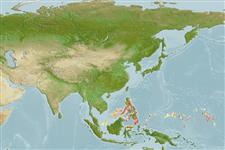Classification / Names
Common names from other countries
Main reference
Size / Weight / Age
Max length : 13.0 cm TL male/unsexed; (Ref. 90102)
Environment
Marine; demersal; depth range 0 - 6 m (Ref. 90102)
Climate / Range
Tropical, preferred ?
Distribution
Short description
Dorsal
spines
(total): 12;
Dorsal
soft rays
(total): 18-21;
Anal
spines: 2;
Anal
soft rays: 19 - 21. Generally uniformly dark brownish, lacking spots on pectoral and caudal fins; Dorsal rays typically 19-20; anal rays typically 20; pectoral rays typically 15; segmented caudal rays 12-13, branched middle nine; nasal, supraorbital, and nape cirri branched or fringed with filaments; upper and lower lip margins smooth; occipital crest absent; last anal ray and caudal peduncle connected by membrane; body somewhat deep, depth at anal-fin origin 3.0-3.3 in SL (Ref. 90102).
IUCN Red List Status (Ref. 115185)
Threat to humans
Harmless
Human uses
More information
Age/SizeGrowthLength-weightLength-lengthLength-frequenciesMorphometricsMorphologyLarvaeLarval dynamicsRecruitmentAbundance
ReferencesAquacultureAquaculture profileStrainsGeneticsAllele frequenciesHeritabilityDiseasesProcessingMass conversion
Tools
Special reports
Download XML
Internet sources
Estimates of some properties based on models
Phylogenetic diversity index
PD50 = 0.5001 many relatives (e.g. carps) 0.5 - 2.0 few relatives (e.g. lungfishes)
Trophic Level
2.0 ±0.00 se; Based on food items.
Resilience
High, minimum population doubling time less than 15 months (Preliminary K or Fecundity.)
Vulnerability
Low vulnerability (24 of 100)
Price category
